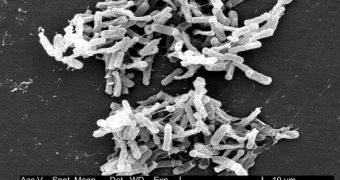A new report made by researchers at the Uniformed Services University of the Health Sciences, Bethesda, Maryland, and published early online, concluded that hospitalized children in the United States are more frequently becoming infected with the bacteria Clostridium difficile.
The article explains that C. difficile colonizes the gastrointestinal tract and can lead to infection, and even if some patients have no symptoms at all, most of them develop diarrhea, toxic megacolon (extreme inflammation and dilatation of the large intestine), perforated bowels or other potentially fatal complications.
The authors write that “in recent years, the incidence of C. difficile infection, number of hospitalizations, associated deaths and severity in adults have been increasing,” and they note that this could be due to a widespread dissemination of a more vicious strain of the bacteria. But these figures could also be because of the “increasing awareness among health care providers, leading to increased testing in symptomatic patients.
"The population-based data in our study provide additional evidence that C. difficile infection cases have a significant effect on the pediatric population," the authors conclude.
"Our study supports previous reports that C. difficile infection is increasing among hospitalized children and provides a background for understanding changing trends and risk factors of C. difficile infection in children.
“Increasing awareness of these risk factors and of an upward trend in hospitalized children with C. difficile infection is the first step in controlling this important infection.”
Cade M. Nylund, MD, of Uniformed Services University of the Health Sciences, Bethesda, Maryland, and colleagues evaluated the trends of C. difficile infection in children, after analyzing the records of hospitalized children in a national database of patients discharged from the hospital in 1997, 2000, 2003 and 2006.
This database included nearly 10.5 million patients, of whom 21,274 (0.2 percent) had C. difficile infection, and it showed that the number of cases increased about 15% each year, from 3,565 in 1997 to 7,779 in 2006.
The C. difficile infection is very dangerous, since affected children have longer hospital stays and higher hospitalization charges, and also a high risk of colectomy – surgical removal of a part of the colon, and even death.
The authors mentioned that there were some kids that seemed more likely to be infected, including those who were white, lived in the West or in urban areas, had private insurance or had other co-occurring diseases, like inflammatory bowel disease.
It also looks like the risk of infection was lower among black or Hispanic children, those who lived in the South, those admitted to rural hospitals, those with Medicaid/Medicare insurance and those who had self-pay or no-pay insurance status.
The only good new is that the authors did not note a rise in the severity of C. difficile infection in children, over time.
Their report will appear in the May print issue of Archives of Pediatrics & Adolescent Medicine, one of the JAMA/Archives journals.

 14 DAY TRIAL //
14 DAY TRIAL //